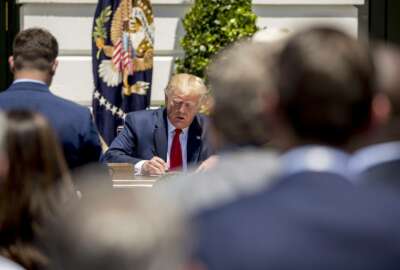
Trump says agencies must revisit ongoing bargaining negotiations, with workforce EOs in full force
The Trump administration has clarified how agencies should proceed with current, ongoing collective bargaining negotiations with federal employee union, now tha...
Best listening experience is on Chrome, Firefox or Safari. Subscribe to Federal Drive’s daily audio interviews on Apple Podcasts or PodcastOne.
The Trump administration late Friday afternoon took another step to clarify exactly how federal agencies must proceed with collective bargaining negotiations, now that all portions of the president’s three workforce orders are in full force.
The U.S. Court of Appeals last week lifted the injunction on the president’s May 2018 executive orders on employee removals, collective bargaining and official time, following a decision from the court to deny employee unions a chance for a rehearing on the merits of the EOs.
“While the District Court’s injunction remained in effect, agencies retained the ability to bargain over subjects covered by the enjoined provisions,” President Donald Trump wrote in an Oct. 11 memo to agency heads. “The executive orders, however, did not address collective bargaining agreements entered into during this period. As a result, it is necessary to clarify agencies’ obligations with respect to such collective bargaining agreements.”
For the agencies who are currently negotiating with federal employee unions, management must now observe and follow all pieces of the president’s workforce executive orders.
“Agencies that remain engaged in collective bargaining negotiations, to the extent consistent with law, shall comply with the terms of the executive orders,” Trump’s memo reads.
Several agencies, including the Departments of Veterans Affairs, Housing and Urban Development and Health and Human Services, are, in fact, currently engaged in negotiations with their federal unions.
The president’s latest clarification could set a new course for those negotiations — and will likely complicate those discussions, which, in many situations, have already been contentious.
For the agencies who had executed a new collective bargaining agreement while the injunction on the president’s executive orders was in place, those agreements may stay in place, according to the administration.
“Where, between the date of the executive orders and the date of the Court of Appeals’ mandate, the parties to collective bargaining negotiations have executed an agreement to incorporate into a new collective bargaining agreement specific terms prohibited by the executive orders, an agency may execute the new collective bargaining agreement containing such terms, and terms ancillary to those specific terms, notwithstanding the executive orders,” the memo reads.
The Social Security Administration reached an agreement with the American Federation of Government Employees late last month, days before the injunction on the president’s workforce executive orders officially lifted Oct. 2.
The latest memo from the president comes exactly one week after the Office of Personnel Management last Friday told agencies officially to begin implementing all parts of the workforce executive orders.
Legal battles over the president’s workforce EOs have stretched on for more than a year after a group of more than a dozen unions sued the Trump administration over them last June.
The injunction had been in place since last August, when a federal district court invalidated nine key provisions from Trump’s workforce executive orders. That meant agencies, technically, couldn’t set strict limits on union representatives’ use of official time or ban the organizations from using government office space.
Federal employees unions, however, have said they’ve continued to experience direct impacts of the president’s EOs over the past year while legal battles have continued.
The Trump administration appealed the federal district court’s decision last September.
But in July, the appeals court dismissed the lower court’s decision because, as the three judges argued, the lower court lacked jurisdiction in ruling on the case. The appeals court didn’t weigh in on the legal merits of the president’s workforce executive orders, a point that ultimately fueled the unions’ request for a rehearing.
Throughout these legal battles, the government has maintained that federal employee unions should take their complaints with Trump’s workforce executive orders in specific collective bargaining instances to the Federal Labor Relations Authority.
The FLRA still lacks a Senate-confirmed general counsel, the only person with deciding authority to issue decisions on an unfair labor practice complaint.
Copyright © 2024 Federal News Network. All rights reserved. This website is not intended for users located within the European Economic Area.
Nicole Ogrysko is a reporter for Federal News Network focusing on the federal workforce and federal pay and benefits.
Follow @nogryskoWFED






